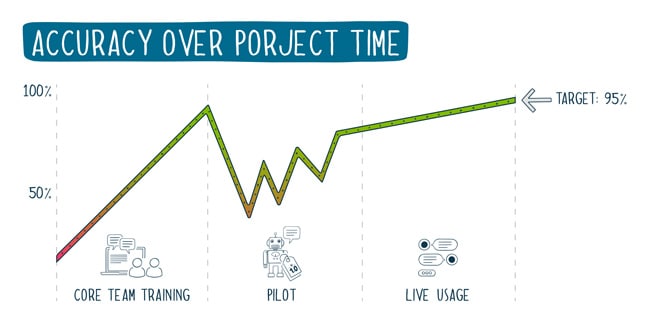Content Management
A chatbot is only as good as the content that underpins it. You also need to make sure that the right content gets to the right user. Therefore, a good content management matrix is absolutely vital to any chatbot project. To ensure the quality needed and aggregate know-how within the organization all content management is handled centrally. This way you can focus more on the content itself.
Chatbots as Content Dispensers
Chatbots are an efficient way of storing large amounts of content and data and making it accessible to the user on demand. A good content matrix is vital in selecting and presenting relevant content and also acts as the basis for the language model necessary to “understand” user intents. Further, it must allow a user centric dialog design with state-of-the-art dialog elements for an optimal and frictionless user experience.
Central Service for Content Management
The content is the central element that defines the quality of bot answers. Training a bot involves building a complex data model with its own rules and logic. We have established a central content management service to gather all the know-how and make it available to you from there. Any chatbot projects within the workplace environment are required to use this service to be able to guarantee a well-performing chatbot. However, you can also access the service even if you perform a bot project outside of the workplace environment. The service works independently from any IT platform or business environment.
The service consists of:
- Chatbot initial training
- Definition of test groups
- Chatbot ongoing improvements
- Monitoring of activities (anonymous) and creating a monthly report
- Ongoing consultancy on functional improvements
Running a chatbot is an ongoing affair. Depending on resources and how well your chatbots performs, the central content management service can help you identify potential areas for improvement. In some cases this may mean shifting the focal area of your bot based on user insights or closing the bot completely and investing your resources elsewhere.
Training & Quality Control
The quality of a chatbot is beyond other measured by the accuracy of answers. For this, we define test groups that challenge the bot by asking random questions considering the defined domain of the chatbot. Our expectation is that a chatbot should have an accuracy of 95% - that means that only one in twenty questions is allowed to get a wrong answer.
In order to attain this level of accuracy several iterations of testing and training are needed. Since both the user landscape and contents are dynamic and evolve over time, having a high level of accuracy does not mean it will stay that way. Even after go-live you have to permanently monitor and tweak your chatbot to keep the level of accuracy up.

Chatbot answer accuracy over time: Getting a 95% accuracy at first shot is unlikely. Therefore, several iterations of testing and training are needed to reach that goal.
Last But Not Least
With so many options at your disposable and all the steps necessary to conceive of your chatbot it is easy to get lost along the way.
- Focus on the essentials. Think about what your bot should do, then concentrate on this use case. Do not try to make a generic know-it-all.
- A good user experience is hard work. It requires a lot of experimentation, trial-and-error and hallway testing. Natural language is messy, and users will surprise you how they approach and use your bot. It's not only high effort in the beginning – continuous monitoring and training is necessary.
Carlos Soriano
E-mail: carlos.soriano@bayer.com
Profolio Manager Interaction
Digital Technologies
Enabling Functions





